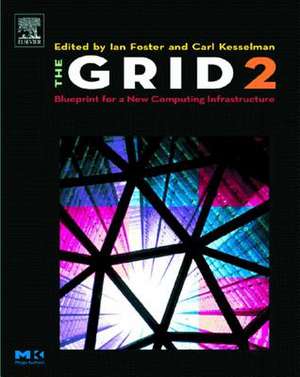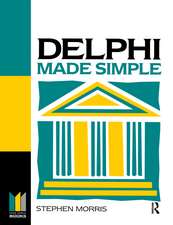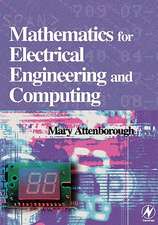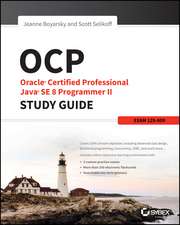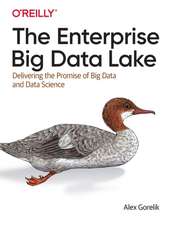The Grid 2: Blueprint for a New Computing Infrastructure
Editat de Ian Foster, Carl Kesselmanen Limba Engleză Paperback – 31 oct 2003
-From the Preface
In 1998, Ian Foster and Carl Kesselman introduced a whole new concept in computing with the first edition of this book. Today there is a broader and deeper understanding of the nature of the opportunities offered by Grid computing and the technologies needed to realize those opportunities. In Grid 2, the editors reveal the revolutionary impact of large-scale resource sharing and virtualization within science and industry, the intimate relationships between organization and resource sharing structures and the new technologies required to enable secure, reliable, and efficient resource sharing on large scale.
Foster and Kesselman have once again assembled a team of experts to present an up-to-date view of Grids that reports on real experiences and explains the available technologies and new technologies emerging from labs, companies and standards bodies. Grid 2, like its predecessor, serves as a manifesto, design blueprint, user guide and research agenda for future Grid systems.
*30 chapters including more than a dozen completely new chapters.
*Web access to 13 unchanged chapters from the first edition.
*Three personal essays by influential thinkers on the significance of Grids from the perspectives of infrastructure, industry, and science.
*A foundational overview of the central Grid concepts and architectural principles.
*Twelve application vignettes showcase working Grids in science, engineering, industry, and commerce.
*Detailed discussions of core architecture and services, data and knowledge management, and higher-level tools.
*Focused presentations on production Grid deployment, computing platforms, peer-to-peer technologies, and network infrastructures.
*Extensive bibliography and glossary.
Preț: 579.18 lei
Preț vechi: 650.77 lei
-11% Nou
Puncte Express: 869
Preț estimativ în valută:
110.85€ • 115.42$ • 93.68£
110.85€ • 115.42$ • 93.68£
Carte indisponibilă temporar
Doresc să fiu notificat când acest titlu va fi disponibil:
Se trimite...
Preluare comenzi: 021 569.72.76
Specificații
Cuprins
Part I: Perspectives
1. Grids in Context
2. The Scientific Imperative
3. The Industrial Imperative
Part II: Framework
4. Concepts and Architecture
Part III: Applications
5. Predictive Maintenance: Distributed Aircraft Engine Diagnostics
6. Distributed Telepresence: The NEESgrid Earthquake Engineering Collaboratory
7. Scientific Data Federation: The World Wide Telescope
8. Medical Data Federation: The Biomedical Informatics Research Network
9. Knowledge Integration: In silico Experiments in Bioinformatics
10. Distributed Data Analysis: Federated Computing for High Energy Physics
11. Massively Distributed Computing: Virtual Screening on a Desktop Grid
12. Enterprise Resource Management: Applications in Research and Industry
13. Interactivity with Scalability: Infrastructure for Multiplayer Games
14. Service Virtualization: Infrastructure and Applications
15. Group-Oriented Collaboration: The Access Grid Collaboration System
16. Collaborative Science: Astrophysics Requirements and Experiences
Part IV: Architecture
17. The Open Grid Services Architecture
18. Resource and Service Management
19. Building Reliable Clients and Services
20. Instrumentation and Monitoring
21. Security for Virtual Organizations: Federating Trust and Policy Domains
Part V Data and Knowledge
22. Data Access, Integration and Management
23. Enhancing Services and Applications with Knowledge and Semantics
Part VI: Tools
24. Application-Level tools
25. Languages, Compilers, and Runtime System
26. Application Tuning and Adaptation
Part VII: Infrastructure
27. Production Deployment: Experiences and Recommendations
28. Computing Elements
29. Peer-to-Peer Technologies
30. Network Infrastructure
31. Bibliography
1. Grids in Context
2. The Scientific Imperative
3. The Industrial Imperative
Part II: Framework
4. Concepts and Architecture
Part III: Applications
5. Predictive Maintenance: Distributed Aircraft Engine Diagnostics
6. Distributed Telepresence: The NEESgrid Earthquake Engineering Collaboratory
7. Scientific Data Federation: The World Wide Telescope
8. Medical Data Federation: The Biomedical Informatics Research Network
9. Knowledge Integration: In silico Experiments in Bioinformatics
10. Distributed Data Analysis: Federated Computing for High Energy Physics
11. Massively Distributed Computing: Virtual Screening on a Desktop Grid
12. Enterprise Resource Management: Applications in Research and Industry
13. Interactivity with Scalability: Infrastructure for Multiplayer Games
14. Service Virtualization: Infrastructure and Applications
15. Group-Oriented Collaboration: The Access Grid Collaboration System
16. Collaborative Science: Astrophysics Requirements and Experiences
Part IV: Architecture
17. The Open Grid Services Architecture
18. Resource and Service Management
19. Building Reliable Clients and Services
20. Instrumentation and Monitoring
21. Security for Virtual Organizations: Federating Trust and Policy Domains
Part V Data and Knowledge
22. Data Access, Integration and Management
23. Enhancing Services and Applications with Knowledge and Semantics
Part VI: Tools
24. Application-Level tools
25. Languages, Compilers, and Runtime System
26. Application Tuning and Adaptation
Part VII: Infrastructure
27. Production Deployment: Experiences and Recommendations
28. Computing Elements
29. Peer-to-Peer Technologies
30. Network Infrastructure
31. Bibliography
Recenzii
"I am struck by the increased emphasis on applications---50% more pages and 4 times the number of chapters---than in the first edition. There is also more material on developing standards, policy, and management. These are true signs of a maturing technology. I hold firm that the Grid will have significant impact on more aspects and segments of IT than the designers originally conceived. The rich experiences in this book will convince the reader as well" --Shane Robison, Executive Vice President and Chief Strategy & Technology Officer, Hewlett-Packard
"The "doing of science" s at an inflection point: Computation, collaboration, visualization and smart storage lie at the heart of what science in the 21st century requires. This extremely readable collection provides a detailed roadmap for creating a global platform that enables this transformation. Most fascinating, to me, is how the Grid creates a technical artifact around which the social practices of science will evolve. Cultures form around artifacts,which is why this book is so important." --John Seely Brown, Former Chief Scientist of Xerox and Director of its Palo Alto Research Center (PARC), co-author of The Social Life of Information, HBSP 2000
"The Grid, 2nd Edition, extends a vision and agenda for another decade. The Grid and web services technologies are enabling pioneering, distributed applications that begin to fulfil the vision. Eventually we"ll look back on the resulting standardization for interoperation as the real revolution. The standards and discipline will enable a new form of software construction, delivery, and even restructure the software industry." --Gordon Bell, Senior Researcher, Microsoft
"Foster and Kesselman have done a great job in documenting the promises and challenges of GRIDs as they evolve from their distributed computing roots to support the virtualization of applications." --Robert Aiken, Director of Engineering Academic Research and Technology Initiatives (ARTI), Cisco Systems Inc.
"Do you want to understand why the computer, as we know it today, will become obsolete? If yes, put your money down, and buy this book. I congratulate the authors." --Philip Emeagwali, Scientist and "A Father of the Internet
"Since the first edition of this book, the Grid has evolved from vision to reality: it has become a computing and data management infrastructure that is widely used in science and engineering, has a strong industrial support and has a large community of developers and users. The two editors of this book, Ian Foster and Carl Kesselman, played a leading role in this transformation. This new edition of The Grid reflects this change. Like the original edition, it is likely to become the one essential reference about the Grid, as well as an excellent introduction to the technologies that are used in the Grid infrastructure.2 --Marc Snir, University of Illinois at Urbana-Champaign
"For proponents of Grid computing and for the IT community that seeks to apply these ideas, this book will serve as a first class tour of the concept space and the details of its implementation. Guaranteed to be thought provoking and an excellent source of information." --Vint Cerf, Internet Pioneer
"The "doing of science" s at an inflection point: Computation, collaboration, visualization and smart storage lie at the heart of what science in the 21st century requires. This extremely readable collection provides a detailed roadmap for creating a global platform that enables this transformation. Most fascinating, to me, is how the Grid creates a technical artifact around which the social practices of science will evolve. Cultures form around artifacts,which is why this book is so important." --John Seely Brown, Former Chief Scientist of Xerox and Director of its Palo Alto Research Center (PARC), co-author of The Social Life of Information, HBSP 2000
"The Grid, 2nd Edition, extends a vision and agenda for another decade. The Grid and web services technologies are enabling pioneering, distributed applications that begin to fulfil the vision. Eventually we"ll look back on the resulting standardization for interoperation as the real revolution. The standards and discipline will enable a new form of software construction, delivery, and even restructure the software industry." --Gordon Bell, Senior Researcher, Microsoft
"Foster and Kesselman have done a great job in documenting the promises and challenges of GRIDs as they evolve from their distributed computing roots to support the virtualization of applications." --Robert Aiken, Director of Engineering Academic Research and Technology Initiatives (ARTI), Cisco Systems Inc.
"Do you want to understand why the computer, as we know it today, will become obsolete? If yes, put your money down, and buy this book. I congratulate the authors." --Philip Emeagwali, Scientist and "A Father of the Internet
"Since the first edition of this book, the Grid has evolved from vision to reality: it has become a computing and data management infrastructure that is widely used in science and engineering, has a strong industrial support and has a large community of developers and users. The two editors of this book, Ian Foster and Carl Kesselman, played a leading role in this transformation. This new edition of The Grid reflects this change. Like the original edition, it is likely to become the one essential reference about the Grid, as well as an excellent introduction to the technologies that are used in the Grid infrastructure.2 --Marc Snir, University of Illinois at Urbana-Champaign
"For proponents of Grid computing and for the IT community that seeks to apply these ideas, this book will serve as a first class tour of the concept space and the details of its implementation. Guaranteed to be thought provoking and an excellent source of information." --Vint Cerf, Internet Pioneer
